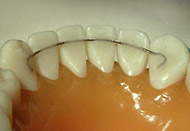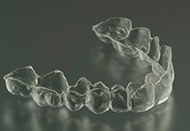You've worked hard for your beautiful smile; keep it that way!
Finally, your braces have been removed and your smile is beautiful, straight, and best of all, metal-free! However, your orthodontic journey isn't quite completed. To keep your smile looking its best, you'll have to wear a retainer to preserve and stabilize your results. Retainers are needed to control or limit potential changes in tooth position. They are used after braces treatment to hold teeth in their correct alignment while the surrounding gums, bone, and muscle adjust to the new positioning of your teeth.
After treatment, we place an upper and lower fixed retainers. We also provide an upper essix retainer to wear at night and make a complimentary upper whitening tray.
Types of Retainers
Fixed Retainers

Bonded lingual retainers are cemented directly to the inside surface of your lower canines (eye teeth). This is one of the best ways to prevent your lower teeth from shifting as it is permanently attached! As with removable retainers, it is important to keep them clean. When brushing, carefully clean the inside of your lower teeth as well as the wire. If your retainer breaks at any time during the retention phase, please do not adjust it yourself. Call us immediately to schedule an emergency appointment.
Essix Retainer

The Essix retainer is a clear removable retainer that fits over the entire arch of teeth. Essix retainers have no metal wires and are virtually invisible. They are very durable, inexpensive and easy to wear.
Pros and Cons
- Removable retainers can be taken out for eating and hygiene routines.
- Removable retainers can get lost easily, so remember to keep yours in the case whenever you remove it to eat or brush.
- A fixed retainer is great if you don't want to keep track of it, or if you don't want to worry about how many hours per day it must be worn.
- Teeth with fixed retainers require a little extra attention to remove tartar while flossing. Patients with fixed retainers often must use floss threaders to pass dental floss through the small spaces between the retainer and the teeth.



 Website Powered by Sesame 24-7™
Website Powered by Sesame 24-7™